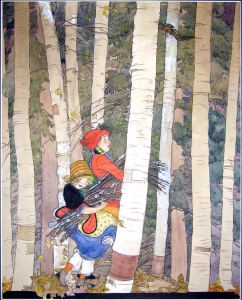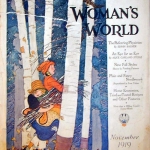
Maginel Wright Enright Barney (1877 or 81-1966), attributed to|Gathering Wood, c. 1919|Cover illustration for Woman’s World (November 1919)|Pencil and watercolor on paper|Original art for cover illustration is from a private collection.

Maginel Wright Enright Barney, born Margaret Ellen Wright, was the younger sister of the architect Frank Lloyd Wright. The name Maginel was a contraction of Maggie Nell, the name her family called her. In 1897-98 she studied art at the School of the Art Institute of Chicago for three terms and then due to a lack of funds began working as a commercial artist in Chicago. At the School of the AIC, Maginel studied under Frederick Richardson, who specialized in the new field of illustration art.
Influenced by the watercolor illustrations of the French mid-late 19th century illustrator, Maurice Boutet de Monvel, Maginel Enright Barney specialized in equally delicate watercolor illustrations of children. Over the course of her career she illustrated over 60 books and produced many magazine cover illustrations for Women’s Home Companion, The Household Companion, and as we see here, Woman’s World.
Around the turn-of-the-century, Woman’s World was one of the many popular women’s magazines available. Despite the contemporary popular magazine by the same name, the periodical I am referring to began publication in 1884 and ended in 1940. Above that magazine’s masthead was the quote that the periodical was published “In the sixteen middle western states” and that “Woman’s World goes into more homes than any other magazine or farm paper.” Letting the consumer know that the magazine was meant to address the interests and concerns of both urban and rural women of the Midwest.
This cover design for the November 1919 issue is both remarkably strong and at the same time very delicate. Like a fairy tale image, it is intriguing since we do not know where the two girls are going, even though we can see that they are carrying the sticks they’ve gathered from the floor of the forest for tinder. The picture is full of interesting details, compelling us to peer at it more closely so as not to miss one of the unexpected twists in the composition, such as the wide-eyed owl swooping down through the trees and the wind-blown revelation of the young girl’s bloomers. The elder girl, dressed in a red hat and coat, looks straight ahead as she moves purposefully through the trees. The younger, looks out at us from under the green-lined brim of her hat, and smiles at her viewer. The girl’s arms are full of branches of white birch and their feet stir the fallen leaves on the floor of the forest.
Maginel Enright constructed a thick black line under their feet to serve as the lower edge of the picture. She also defied her own edge by painting a tumble of leaves over it, under the young girl’s shoes and again at the far right and left of the image. The black edge seems to imply a stage edge for the action, even though she did not create a corresponding proscenium at the top or sides of the scene. The owner of the original art work says that in the center of the work a separate piece of paper is overlaid on the image.
When the publisher transformed Maginel Enright’s painting into the magazine cover they made some modifications. First, they cropped the sides of the painting making the forest much less encompassing. Second, they transformed the branches of evergreens peeking through the birch trees from green into tones of blue. Finally they punched up the color of the exposed segments of birch from pale beige into a stronger yellow tone. The publisher’s changes don’t essentially change Enright’s image, but it does show us one of the differences between illustration art and the so-called fine art—when you do work for hire, the one who pays for the work has ultimate control over the artist’s product.
Woman’s World used Maginel Wright Enright Barney’s work for their cover images for many years. So highly did they prize her compositions that they even show-cased her work in the February 1922 issue of their magazine: “Combining a rare imagination with a most unusual talent in the treatment of color, Mrs. Enright’s quaint children, which appear exclusively on the front covers of Woman’s World every month, have a freshness and charm all their own.” *
* “Maginel Wright Enright: The Creator of the Covers on Woman’s World” in Woman’s World (February 1922)
November 26, 2009
By Joyce K. Schiller, Curator, Rockwell Center for American Visual Studies
Norman Rockwell Museum






